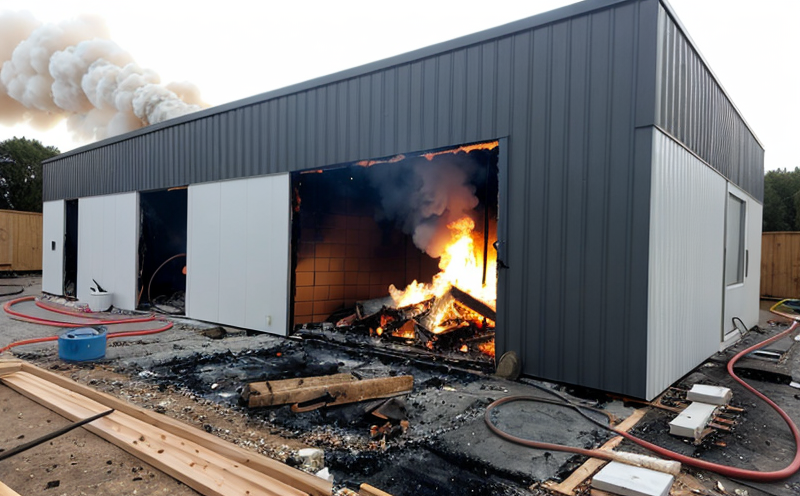Smoke Density Measurement according to ASTM E662
The measurement of smoke density is a critical aspect in fire safety testing, especially when evaluating materials and products used in construction. Smoke density can significantly impact the spread of fire within buildings by reducing visibility for occupants and firefighters alike. According to ASTM E662-18, this standard provides methods for measuring the light transmittance through smoke produced from the combustion of various materials.
The test is particularly relevant in sectors such as construction, where the performance of insulation materials and cladding systems must be rigorously assessed. This includes ensuring that these materials do not contribute excessively to smoke production during a fire event. The methodology involves subjecting specimens under controlled conditions to a prescribed flame source until they reach a steady state of combustion. Light transmittance is then measured through the resulting smoke using an integrating sphere and photometer.
The ASTM E662 standard offers two primary methods for testing, each designed to assess different aspects of smoke behavior:
- Method A: This method measures light transmittance through a single layer of the material being tested.
- Method B: This approach evaluates multiple layers of the material or assemblies that simulate real-world conditions, such as insulation and cladding systems on buildings.
The test parameters are meticulously defined to ensure consistency across different laboratories. Specimens must be prepared according to ASTM E662 guidelines, which specify dimensions, thicknesses, and how they should be cut or shaped. The apparatus used for this testing includes an integrating sphere photometer calibrated to ISO 7026 standards.
The procedure involves igniting the specimen in a specially designed furnace under controlled atmospheric conditions. Temperature, humidity, and air flow rates are carefully monitored to ensure reproducibility of results. Once ignited, the sample is allowed to burn until it reaches a steady state where there is no significant change in smoke production.
The light transmittance through the resulting smoke is measured using an integrating sphere photometer placed at a specific distance from the furnace outlet. The measurement provides an accurate representation of how much visible light passes through the smoke generated by the specimen. This value directly correlates with the degree of obscuration caused by the smoke.
Accurate measurements according to ASTM E662 are crucial for ensuring compliance with building codes and standards that prioritize fire safety and occupant evacuation. For instance, in Europe, Directive 2019/947/EU on Construction Products requires manufacturers to demonstrate that their products meet certain performance criteria regarding smoke production. By adhering to ASTM E662, laboratories can provide reliable data supporting the compliance of construction materials with these regulations.
Additionally, this testing method is valuable in research and development (R&D) efforts aimed at improving fire-resistant materials. Engineers may use the results from ASTM E662 tests to optimize formulations or design new products that offer superior smoke control properties while maintaining structural integrity and thermal insulation capabilities.
Why It Matters
The significance of accurate smoke density measurement cannot be overstated, especially in environments where fires are a potential risk. Understanding how materials contribute to smoke production is vital for several reasons:
- Fire Safety Compliance: Many jurisdictions have strict regulations mandating that construction products meet specific performance criteria related to fire behavior. Smoke density measurements ensure compliance with these standards.
- Occupant Safety: Reduced visibility due to dense smoke can severely impede emergency evacuations, making accurate measurement essential for enhancing safety protocols.
- Structural Integrity: Materials that produce less smoke during fires are more likely to maintain their structural integrity longer, providing better protection against further spread of the fire.
Incorporating ASTM E662 into product development processes helps manufacturers create safer products, reducing risks associated with fire hazards. It also aids in designing buildings that can withstand fires without compromising safety or functionality.
Benefits
Implementing smoke density measurement according to ASTM E662 brings numerous benefits across various stakeholders:
- Enhanced Safety: By reducing the amount of smoke produced, materials contribute less to fire spread and improve visibility during emergencies.
- Regulatory Compliance: Laboratories can provide verifiable data that meets international standards like ASTM E662, ensuring compliance with local regulations.
- Economic Efficiency: Products that pass rigorous testing are more likely to gain market acceptance, reducing the need for costly recalls or redesigns later in development cycles.
- Innovation: The insights gained from ASTM E662 tests can drive innovation in material science and fire safety technology.
The benefits extend beyond just compliance and safety; they also contribute to a more sustainable built environment by promoting the use of safer, more efficient materials.
Eurolab Advantages
At Eurolab, we pride ourselves on delivering comprehensive fire safety testing services that meet or exceed international standards. Here are some key advantages:
- Accurate and Reliable Results: Our state-of-the-art facilities and experienced staff ensure precise measurements according to ASTM E662.
- Comprehensive Testing Capabilities: We offer a wide range of fire safety tests, providing holistic evaluations of materials and products.
- Expert Technical Support: Our team offers guidance on specimen preparation and interpretation of results, ensuring clients understand their test outcomes fully.
- State-of-the-Art Equipment: Utilizing cutting-edge instruments calibrated to international standards ensures consistent, accurate measurements.
We are committed to helping our clients achieve compliance with global regulations and standards while fostering continuous improvement in fire safety practices.





